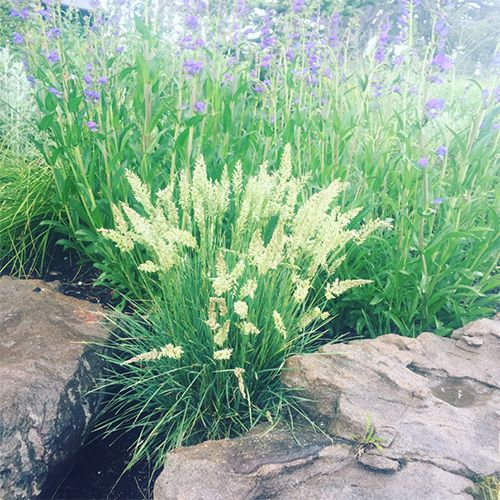Prairie Junegrass in the Landscape

Beth MacFawn, Bozeman, MT
Scientfic Name: Koeleria macranthaCommon Name: June Grass, Prairie Junegrass, Crested Hairgrass
Description: Prairie Junegrass is a perennial, cool season grass, upright in growth, with fine-textured tufts of leaves topped by narrow erect flower panicles. Growth height ranges from 0.5 to 2 ft. tall. Newly emerged inflorescences are light green and translucent, and 2 to 5 in. long, and are held well above the foliage. They dry to a pleasing buff colour.
This Intermountain native grass can be found in prairies and open meadows. It is ideal for naturalizing a meadow garden, can be used in seed mixes for restoration of native prairie, applied to mass/block plantings or as a low maintenance lawn. This species can be used in hot, dry sites.
Native Habitat: Koeleria macrantha is adapted to a wide variety of climates, soils and native plant communities. The North American distribution includes Canadian provinces, eastern Alaska, and the majority of United States with the exception of southern states and New England. Considered endangered in Ohio and Kentucky and critically imperiled in Louisiana. Commonhabitats are rangelands, plains and open forestlands. This species can be found at elevations ranging from 4,000 to 10,000 feet.
Cultural Requirement
Soil: Most commonly found on rocky to sandy loam sols of low fertility but also occurs on clay soils with adequate drainage. Prefers a soil pH of 6.0 to 8.0.
Moisture Tolerance: Good drought tolerance. Easily grown in full sun on moist or moderately dry soils. Capable of growing under xeric conditions. It does best with 12 to 20 inches of annual precipitation.
Sun/Shade/Preference: Full sun to partial shade.
Transplanting: Easily transplanted as seedlings from flats into pots and from pots into the garden. Plants are easily managed in small pots for a short period of time but require well–drained media and careful watering to remain healthy for an extended period of time. Makes a good subject for one-gallon pots if not overwatered and if over-wintered where the pots do not freeze.
Propagation: Prairie Junegrass is not recommended for fall or dormant fall seeding. Best propagated by seed or division, in the spring. There are about 1.8 million seeds per pound (+/- 20%) although viability is often below 50 percent. At least 1 lb. per acre is used to seed pasture which may require 2 to 3 years for establishment prior to grazing. Application of fertilizer to wild ecotypes is usually not recommended.
Maintenance (pruning, fertilization, deadheading, division, irrigation, etc): Prairie Junegrass requires little maintenance. Seedheads can be cut back prior to new year’s growth. In turf settings this species tolerates repeated low mowing
Insect, disease, or other problems: Prairie Junegrass is often free of significant insect and disease problems but is occasionally the target of striped flea beetles, rusts, leaf spots or blights.
Landscape Value
Use in the Landscape: Prairie Junegrass flowers in April to June and seed matures in July or August depending upon location and climate. It can be used in mass/block plantings, in a mixed perennial bed, or in turf settings. This grass tolerates foot traffic better than many other native grasses. It is very resistant to fire and will often increase in percent cover after a fire or other disturbance. Good drought tolerance and fibrous roots make this species useful for revegetation and erosion control in disturbed sites.
Foliage: Clusters of narrow, markedly veined, light green to bluish green leaves grow to about 7 inches tall. The leaves are flat to in-rolled with slightly rough edges and boat-shaped, pointed tips.
Flower: Erect seedheads appear as dense, pale green to purplish spikes, tapered at both ends. They spread to become an open panicle during flowering. Fine hairs are found on the reproductive stem just below the seedhead.
Timing: May to June. Seedhead matures in July or August.
Form: Upright in habit, with fine-textured tufts of leaves topped by narrow erect flower panicles.
Texture: Medium
Ultimate Size: Mature plants are typically 4 to 6" of leaf height, with an additional 6 to 8" of inflorescences.
Rate of Growth: Slow.
Suggested Plant Partners: Companions for Prairie Junegrass can be xeric in nature and include some plants with spring to early summer bloom times. To complement this species’ early spring green-up, partner with groundcovers such as Phlox subulata, Armeria sibirica, or Arabis species. Artemisia frigida, Aquilegia species, Geum triflorum, Geranium species, Iris missouriensis, and Penstemon species would be complementary to the Junegrass seedhead.
Availability: Potted plants can be purchased from specialty native plant nurseries. Seed can usually be purchased from native plant seed suppliers.
Cultivars: Two native germplasms selected for roadside planting, prairie restoration and landscaping have been released from the Elsberry Plant Materials Center in Elsberry, IA. ‘Barkoel’ prairie Junegrass is an improved cool season turfgrass cultivar developed from plants native to northern Europe. ‘Barkoel’ seed is available from Barenburg USA, Tangent, OR.
References:
USDA, NRCS, Plant Fact Sheet. The PLANTS Database. (http://plants.usda.gov) Plant Fact Sheet.
USDA, NRCS, 2006. Plant Guide. The PLANTS Database, Version 061010. (http://plants.usda.gov)
Darke, Rick. 1999. The Color Encyclopedia of Ornamental Grasses. Timber Press.
